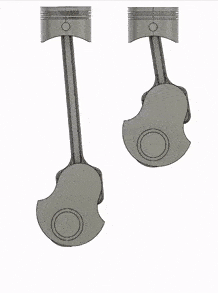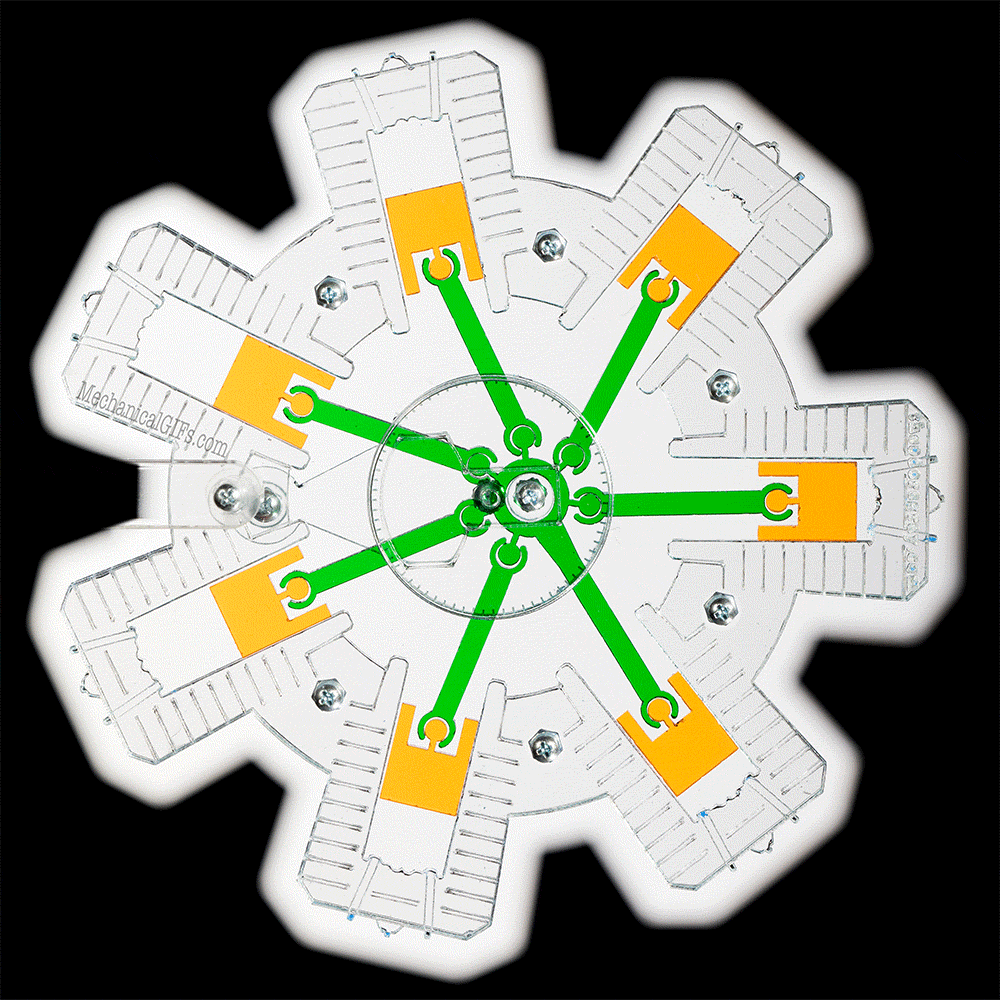It is Friday my guys, 07:46, 24/02/2023
I will try again to design this insane hydraulic pump that needs to pump out 17-34 thousand liters per minute.
Unless I'm able to disassemble an engine block to measure the dimensions in order to calculate the area necessary for pump this much fluid (or just find a complete kit on the cheap), I think I will give up on the idea for using combustion engine parts to build the pump.
On the other hand, I think I will try to design this pump using hydraulic cylinders and/or just conventional hydraulic pumps.
The problem with conventional hydraulic pumps is that these aren't made to move too much liquid, these are made to pump a small amount of liquid at an insane pressure.
There are centrifugal water pumps, but I don't know how well these would peform with hydraulic oil and how much pressure these would generate.
Again, I took some time looking for hydraulic pump ads on the internet, and all of them are insanely expensive.
I guess I will be forced to work with hydraulic/pneumatic cylinders as pumps.
The problem is:
How the heck do I calculate the torque necessary to rotate those?

Off-topic:
As you can imagine based on my previous Project Logs, when I say "asking around" I mean asking both on generic question websites (like Quora, WikiAnswers etc), specilized forums/websites (like Stack Exchange) and sci-fi writting advice forums/websites.
And in this sci-fi forum, someone suggested for my "history" making bio-mechs.

(image from the manga called "Kaiju 8", there were other better examples, but this is the most "E-rated" bio-mech suit I could find)
Basically, taking animal body parts, use electrict stimuli and making a mech. Because these can "self-heal", power themselves up by eating food, are abundant in our meat-based economy/society and so on.
(I don't know what you will think of me after saying this but...) I do agree with what this person said.
It kinda makes sense: we literally eat all parts of a cow on a daily basis, why not use their corpses to make bio-robots?

But as you can expect, I doubt that a mere rando on the internet would be able to make one of these to work at all.
I mean, assuming the cow is dead and/or you removed its brain for ethics sake, made intrusive surgeries to make it bipedal and add other components to make it "alive" and responding to your commands...
How would one do it?
First you would need to keep the animal corpse's body functions working, and I don't know how to do it.
Assuming you simply pump blood with oxygen with an external artificial lung or simply letting the inner lung working as always, what about the nutrients? The infections? Diseases?
What about the immunologic rejection?
And yes, prothestics that go inside your body (and even transplants) do, in fact, get eventually rejected by your body immunologic system.

And this was a big plot on "Cyberpunk: Edgerunner", the Cyberpunk 2077 anime adaptation.
Well, if anyone out there have some knowledge on veterinary matters, have a cow laying around and want to "build" a Mech "on the cheap" call me. lol

The flesh may be weak, but it has its uses...
The pistons:
Taking into consideration that most of pneumatic/hydraulic pistons cost around 20-50 reais (4-10 dollars), and I would need at least a dozen of those, I don't think it will be cost effective.
And so, I think I will make DIY/homemade piston cylinders for the hydraulic pump.
Initially I didn't want to make these because:
- Precision is necessary for the mechanism to work.
- It is quite labour intensive.
- The cheapest parts are in plastic, but plastic has too much friction.
- Depending on the material, I would need to use expensive tools (like welding machines).
Well, the idea I had was to use conventional PVC pipes with its insides covered on some low friction material.
... But I couldn't find anything that could easily be applied.
I read on google that Nylon and PTFE (Teflon) have low friction properties.
So I think I will take one of those teflon tapes used on tubes to avoid leakage and melt it on the surface of the tubes that are meant to slide together.
On Project Log 16 I tried to calculate a hydraulic pump using pneumatic cylinders with 16mm of bore diameter and 50mm of stroke because this was the cheapest option, but I believe I will keep the 50mm stroke simply because of the mechanical advantage.
The furthest from the axis of rotation of the crankshaft the piston's connecting rod is, the more torque one will need to make it move.

So I will try to keep this rotating closer to the axis, moving faster, but with low requirement of torque.

Both of the piston's crankshafts are rotating at same speed, but the left one is moving faster, and it has a better mechanical advantage.
One thing that I will also do to increase fluid flow.
Well, the video above is showing a guy making a crankshaft out of wood, but for some reason it blocks other websites from showing the thumbnail.
There are other videos on the subject, but I wasn't able to find them again.
One in specific is a video tutorial showing how to make a wooden crankshaft, but unlike the video above, the person used some metal slides to avoid the axis from rotating on themselves (one of the reasons crankshafts are made out of a single piece).
There are great tutorials on the least expected videos. :|
By the way, like I talked on Project Log 20, there always is the option to use ultra high performance concrete since concrete has the same density as Aluminium.
You can actually make an UHPC using carbon fiber, glass fiber and so on.
The only problem is that these would take some while to make and/or to dry out.
Anyway, calculating:
First, let me just calculate how much power I would need with conventional hydraulic pumps, just to say I at least tried.
So, most hydraulic pumps are rated for dozens of horsepower in order to achieve hundreds of bars of pressure.
So, assuming that normal hydraulic pumps require 5 horsepower to achieve 50 bar, and I just want 4 bar, this means I would need 1.25 horsepower (950 watts) in order to pump 54 liters per minute of hydraulic fluid at 4 bars of pressure.
This means that if I wanted to achieve 17000 liters per minute, I would need 314 hydraulic pumps each using 1.25 hp of power to rotate.
This means I would need 392.5 horsepower in total, or 294218 watts or power.
Ugh...
For perspective, race cars have 500hp. :|
Of course, I could take a conventional car engine and tune it up, but I feel like taking a fricking car engine to make a mech that will never run as fast as a car is... Not efficient or practical.
I mean, with the price of fuel these days, I doubt it would even be cost efficient...
But if you want to make a Mech no matter what and have the money to do so... Why not?
IF I had the money, yes, I would do this mech no matter what.
But I don't want to spend 70,000 reais (13,434) on 77 hydraulic pumps. :|
Nor 282,600 reais (54,236 dollars) on 314 hydraulic pumps >.>
The only people insane enough to do that would be Mr.Beast and/or Hacksmith.
Assuming I will be using a 100mm (10cm) PVC tube with length around 50mm (I say "around" because it can be longer to fit the check valves and so on), let's say this is the "working area" of 10x5cm, I would have 0.393 liters of fluid in a single go.
In order to deliver 34 thousand or 17 thousand liters per minute, in this case 250-500 liters per second I would need 712 cylinders working together.
:|
Well, I will try to like, cut it in 4 parts in order to separate each limb, so I can have a more solid picture of this insanity.
So, If I work with 1/4 of 17300 liters per minute, I would need 4341 liters per minute, which is 72,35 liters per second.
:| ²
Well, obviously, this would be 7 meters long if I organized these in a straight line, but I could use the radial configuration...?

Radial configurations normally work with odd numbers, like 7.
Which means this would be more or less a 1 meter long hydraulic engine, and I would need 4 of those stacked together...
And I don't know how much torque these would need...
I'm writting this after finishing the project log, so I dunno how it will look like for you, viewer, reading me contradict myself 3 times in a row about the final objective.3
To be honest, it doesn't matter, It probably would end up in the 1000's just like the high pressure pistons.
The thing is: the power requirement simply busted through the roof.
There is no point in pursuing this insane amount of engineering, and thus, I need to tune my expectations for this mech way down for a reallistic aproach.
Oh yeah, I'm commiting a mistake here, I'm assuming that this has 1 revolution per second, which gives 60 revolutions per minute.
Cars normally have 2 cylinders working per revolution and achieving 5000 rpm, which is 82 revolutions per second.
... Although I doubt this crazy amount of cylinders with something with such viscosity as hydraulic oil would allow for faster rpms.
Pistons?
Well, you will probably see this as the last part of the project log by the time I finish writing this crap, but I would like to say that this endeavor around McKibben Muscles is probably not worth it.
I mean... The hydraulic cylinders I talked about on Project Log 27 just need 5hp-15hp engine to work, while this thing here becomes even more of a clausterf*ck of poorly calculated concepts that may or may not work out.
Edit¹:
I miss calculated said project log, I would actually need around 1000 hp to make this crap work.
So my calculation of "half of 15hp" is not right...
I would actually need 1010 HP of power to rotate 77 hydraulic pumps...
:/
Well, the only positive thing is that since carbon fiber can be custom shaped, maybe I can increase its size, so I would need less bars of pressure.
Accordingly to this force, pressure and area calculator, I would need a piston with 49cm² (a circle with 14cm of diameter) of area to lift 5 tons, and 29cm² (a circle with 12cm of diamter) to lift 3 tons both under 100 bars of pressure.
I just remembered about this pneumatic to hydraulic system.
Basically, you pump in air at a pressure of 150/175 PSI and it generates 10,000 PSI of pressure on the hydraulic end.
How it works:
(I don't know which one is like the video about the BVA air hydraulic pump)
I also thought on using a spireld copper pipe with a metal ball on its interior.
Air would go by one side and hydraulic oil would go into the other.
The air would continiously push the ball, and thus, the hydraulic fluid, increasing pressure.
This happens because of the Pascal's law that tells that hydraulic liquids can work like a lever: you push a lighter load through a larger distance and you can lift a heavier load over a smaller distance.
And since even air pump for car tires can easily achieve 300 PSI, maybe I really don't need 1000 hp to pump all this liquid.
However, I don't know how to "recharge" the fluid.
Basically, once the hydraulic fluid is pushed and does work, then the ball would have to travel all the way back to the beginning.
And this travel would cause a delay before actuation... Assuming you don't have the spiral charged before the actuation.
I guess this would work more like a hydraulic accumulator rather than an air to hydraulic pump... hum...
The only problem with the 5 ton hydraulic cylinder is the weight and the price. Those alone may weight more than a ton, probably 2; and on top of that, are thousands of reais.
Maybe I could use carbon fiber tubes/rods on the cylinders to deal with the weight issue, but it will definitely be hard and/or be more expensive to build them.
Maybe glass fiber will be cheaper, but I don't know if it will be able to take 150 bars of pressure... hum...
I couldn't find any hydraulic cylinder made out of carbon fiber, but I did find some papers and data sheets for customized ones.

Dunno how to explain, but the most amount of pressure is normally around the holes/openings of an object, which could explain why it is thinner at the center rather than the extremities.
I have no idea where to find the inner rod, of it it could be better if it was carbon fiber.
At 4:10 it shows how a carbon fiber tube with 25mm of thickness could withstand 2 tons of weight in the vertical.
I think that this will be kinda of a "north" for when I try it out.
The titanium one actually was able to withstand 9 tons, crazy. And also crazy expensive.
Also, the aluminium one was able to withstand more than carbon fiber...
Interesting...
But as you can imagine, hydraulic cylinders need to be able to withstand both tensile and compression forces.
Tensile for the increase in pressure inside of it and compression when the weight is loaded over it.
There are also electrohydrostatic actuation systems, I saw that those are used on fighter jets.
And for what I could understand, the two ways in the hydraulic cylinder are at equal pressure and equal surface area, so you "just" have to do is change which side has more fluid.
Besides sounding simple, this seems... Complicated and expensive...
Another option:
A better alternative compared to using 5 ton hydraulic actuators could be...
Simply toning it down.
I don't really need to lift 1-5 tons of crap, this will allow for smaller, cheaper and less powerhungry actuators.
The problem is... I don't know which is the best power rating for this thing, I thought on 1-5 ton of power simply for redundancy's sake.
I mean, I definitely wouldn't have any problem on walking, running jumping and carrying weight with 1 ton capacity, right?
If I put a 1 ton muscle on the arm, I will be able to lift just 300 kg with the arm, if I put a 300 kg acuator on the arm, I will only be able to lift 90kg.
Homemade PVC cylinders can lift around 150kg (I think), so I would just need 2 of those for the arms.
And besides, i could just go back to normal McKibben muscles, like the Steel braided ones in HackSmith.
Those could lift 200 lbs (100kg), so I would need 3 of those per bundle of muscles.
And maybe, those multi-filament McKibben muscles would finally be viable for this project.
And braiding them could be a viable option too.
But at least in this case, things would be small enough for an exosuit instead of a mech.
Dunno what to do from here...
Should I try to measure how much pneumatic flow I would need for the air-hydraulic pump?
Or just step down my expectations for this mech/exosuit?
Discussions
Become a Hackaday.io Member
Create an account to leave a comment. Already have an account? Log In.
lol, I have considered building a large quadruped robot that I can ride on, but ultimately concluded that it would be easier to just buy a horse.
If you're going to use low pressure, use air rather than hydraulic fluid. High flow rate of dense fluid will cause all sorts of trouble.
Are you sure? yes | no
That is true, but you really can't control pneumatic in a progressive and precise way.
It is quite a struggle :/
Are you sure? yes | no